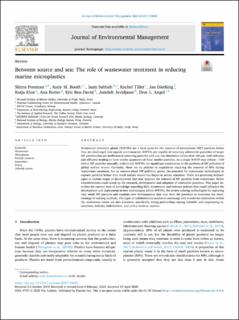| dc.contributor.author | Freeman, Shirra | |
| dc.contributor.author | Booth, Andy | |
| dc.contributor.author | Sabbah, Isam | |
| dc.contributor.author | Tiller, Rachel | |
| dc.contributor.author | Dierking, Jan | |
| dc.contributor.author | Klun, Katja | |
| dc.contributor.author | Rotter, Ana | |
| dc.contributor.author | Ben David, Eric | |
| dc.contributor.author | Javidpour, Jamileh | |
| dc.contributor.author | Angel, Dror | |
| dc.date.accessioned | 2020-05-07T08:04:12Z | |
| dc.date.available | 2020-05-07T08:04:12Z | |
| dc.date.created | 2020-04-19T21:25:18Z | |
| dc.date.issued | 2020 | |
| dc.identifier.citation | Journal of Environmental Management. 2020, 266 110642-?. | en_US |
| dc.identifier.issn | 0301-4797 | |
| dc.identifier.uri | https://hdl.handle.net/11250/2653571 | |
| dc.description.abstract | Wastewater treatment plants (WWTPs) are a focal point for the removal of microplastic (MP) particles before they are discharged into aquatic environments. WWTPs are capable of removing substantial quantities of larger MP particles but are inefficient in removing particles with any one dimension of less than 100 m, with influents and effluents tending to have similar quantities of these smaller particles. As a single WWTP may release >100 billion MP particles annually, collectively WWTPs are significant contributors to the problem of MP pollution of global surface waters. Currently, there are no policies or regulations requiring the removal of MPs during wastewater treatment, but as concern about MP pollution grows, the potential for wastewater technologies to capture particles before they reach surface waters has begun to attract attention. There are promising technologies in various stages of development that may improve the removal of MP particles from wastewater. Better incentivization could speed up the research, development and adoption of innovative practices. This paper describes the current state of knowledge regarding MPs, wastewater and relevant policies that could influence the development and deployment of new technologies within WWTPs. We review existing technologies for capturing very small MP particles and examine new developments that may have the potential to overcome the shortcomings of existing methods. The types of collaborations needed to encourage and incentivize innovation within the wastewater sector are also discussed, specifically strong partnerships among scientific and engineering researchers, industry stakeholders, and policy decision makers. | en_US |
| dc.language.iso | eng | en_US |
| dc.publisher | Elsevier Ltd | en_US |
| dc.rights | Navngivelse 4.0 Internasjonal | * |
| dc.rights.uri | http://creativecommons.org/licenses/by/4.0/deed.no | * |
| dc.subject | Wastewater | en_US |
| dc.subject | Microplastic | en_US |
| dc.subject | Particle removal | en_US |
| dc.subject | Innovation | en_US |
| dc.subject | Policy | en_US |
| dc.subject | Jellyfish mucus | en_US |
| dc.title | Between source and sea: The role of wastewater treatment in reducing marine microplastics | en_US |
| dc.type | Journal article | en_US |
| dc.type | Peer reviewed | en_US |
| dc.description.version | publishedVersion | en_US |
| dc.rights.holder | 0301-4797/© 2020 The Authors. Published by Elsevier Ltd. This is an open access article under the CC BY license | en_US |
| dc.source.pagenumber | 110642-? | en_US |
| dc.source.volume | 266 | en_US |
| dc.source.journal | Journal of Environmental Management | en_US |
| dc.identifier.doi | 10.1016/j.jenvman.2020.110642 | |
| dc.identifier.cristin | 1807041 | |
| dc.relation.project | EC/H2020/774499 | en_US |
| cristin.ispublished | false | |
| cristin.fulltext | original | |
| cristin.qualitycode | 1 | |

